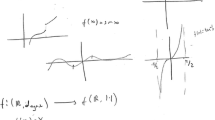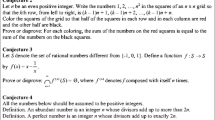Abstract
Constructing an example can be a rich and complex activity, interesting to investigate mathematical thinking and with many potentialities in mathematics education. In this article, I analyse processes involved in example generation, with particular emphasis on production and transformation of signs representing mathematical objects and on generation of inferences. The richness and complexity of these processes will also be shown through the notions of prototypes, concept image and concept definition. This investigation reveals aspects that are significant both in education and for the reflection on cognitive and cultural aspects of mathematical thinking.









Similar content being viewed by others
References
Alcock, L. (2004). Uses of examples objects in proving. In M. Johnsen Høines & A. Berit Fuglestad (Eds.), Proceedings of the 28th conference of the international group for the psychology of mathematics education (Vol. 2, pp. 17–24). Bergen: Bergen University College.
Alcock, L., & Inglis, M. (2009). Representation systems and undergraduate proof production: a comment on Weber. Journal of Mathematical Behavior, 28, 209–211.
Antonini, S. (2003). Non-examples and proof by contradiction. In N. A. Pateman, B. J. Dougherty, & J. Zilliox (Eds.), Proceedings of the 2003 joint meeting of PME and PMENA (Vol. 2, pp. 49–55). Honolulu, Hawai’i: CRDG College of Education, University of Hawai’i.
Antonini, S. (2006). Graduate students’ processes in generating examples of mathematical objects. In J. Novotnà, H. Moarovà, M. Kràtkà, & N. Stelìchovà (Eds.), Proceedings of the 30th conference of the international group for the psychology of mathematics education (Vol. 2, pp. 57–64). Prague: Charles University.
Antonini, S. (2010). A model to analyse argumentations supporting impossibilities in mathematics. In Proceedings of the 34th conference of the international group for the psychology of mathematics education (Vol. 2, pp. 153–160). Belo Horizonte: PME.
Antonini, S., Furinghetti, F., Morselli, F., & Tosetto, E. (2007). University students generating examples in real analysis: where is the definition? In D. Pitta-Pantazi & G. Philippou (Eds.), Proceedings of the fifth congress of the European Society for research in mathematics education, CERME 5 (pp. 2241–2249). Larnaca, Cyprus. http://ermeweb.free.fr/CERME5b/.
Antonini, S., & Mariotti, M. A. (2008). Indirect proof: what is specific to this way of proving? Zentralblatt für Didaktik der Mathematik, 40(3), 401–412.
Arzarello, F. (2006). Semiosis as a multimodal process. Relime, Número Especial, 267–299.
Balacheff, N. (1987). Processus de preuve et situations de validation. Educational Studies in Mathematics, 18(2), 147–176.
Bills, L., Mason, J., Watson, A., & Zaslavsky, O. (2006). Research Forum 02. Exemplification: the use of examples in teaching and learning mathematics). In J. Novotnà, H. Moarovà, M. Kràtkà, & N. Stelìchovà (Eds.), Proceedings of the 30th conference of the international group for the psychology of mathematics education (Vol. 1, pp. 25–153). Prague: Charles University.
Boero, P. (2001). Transformation and anticipation as key processes in algebraic problem solving. In R. Sutherland, T. Rojano, A. Bell, & R. Lins (Eds.), Perspectives on school algebra (pp. 99–119). Dordrecht: Kluwer.
Boero, P., Garuti, R., & Lemut, E. (1999). About the generation of conditionality of statements and its links with proving. In O. Zaslavski (Ed.), Proceedings of the 23rd conference of the international group for the psychology of mathematics education (Vol. 2, pp. 137–144). Haifa: PME.
Bratina, T. A. (1986). Can your students give examples? Mathematics Teacher, 79, 524–526.
Capobianco, M., & Molluzzo, J. C. (1978). Examples and counterexamples in graph theory. New York: North Holland.
Carlson, M. P., & Bloom, I. (2005). The cyclic nature of problem solving: an emergent multidimensional problem-solving framework. Educational Studies in Mathematics, 58(1), 45–75.
Dahlberg, R. P., & Housman, D. L. (1997). Facilitating learning events through example generation. Educational Studies in Mathematics, 33, 283–299.
Duval, R. (1995). Sémiosis et Pensée Humaine. Bern: Peter Lang.
Edwards, A., & Alcock, L. (2009). How do undergraduate students navigate their example spaces? In Proceedings of the 13th annual conference on research in undergraduate mathematics education. http://sigmaa.maa.org/rume/crume2010/Archive/Edwards.pdf.
Furinghetti, F., Morselli, F., & Antonini, S. (2011). To exist or not to exist: example generation in real analysis. Zentralblatt für Didaktik der Mathematik (this issue).
Gelbaum, B. R., & Olmsted, J. M. H. (1964). Counterexamples in analysis. San Francisco: Holden-Day.
Gelbaum, B. R., & Olmsted, J. M. H. (1990). Theorems and counterexamples in Mathematics. New York: Springer.
Harel, G., & Sowder, L. (1998). Students’ proof schemes: results from exploratory studies. In A. Schoenfeld, J. Kaput, & E. Dubinsky (Eds.), Research on collegiate mathematics education (Vol. 3, pp. 234–283). Providence: American Mathematical Society.
Hazzan, O., & Zazkis, R. (1997). Constructing knowledge by constructing examples for mathematical concepts. In E. Pehkonen (Ed.), Proceedings of the 21st conference of the international group for the psychology of mathematics education (Vol. 4, pp. 299–306). Helsinki: University of Helsinki-Lahti Research and Training Center.
Hintikka, J., & Remes, U. (1974). The method of analysis: Its geometrical origin and its general significance. Dordrecht: Reidel Publishing Company.
Iannone, P., Inglis, M., Mejia-Ramos, J. P., Siemons, J., & Weber, K. (2009). How do undergraduate students generate examples of mathematical concepts? In M. Tzekaki, M. Kaldrimidou, & H. Sakonidis (Eds.), Proceedings of the 33rd conference of the international group for the psychology of mathematics education (Vol. 3, pp. 217–224). Thessaloniki: PME.
Khaleelulla, S. M. (1982). Counterexamples in topological vector spaces. Berlin: Springer.
Lakatos, I. (1976). Proofs and refutations: the logic of mathematical discovery. Cambridge: Cambridge University Press.
Lakoff, G. (1987). Women, fire, and dangerous things. Chicago: University of Chicago Press.
Mason, J., & Klymchuk, S. (2009). Using Counter-examples in calculus. London: Imperial College Press.
Polya, G. (1945). How to solve it. Princeton: Princeton University Press.
Presmeg, N. (1992). Prototypes, metaphors, metonymies and imaginative rationality in high school mathematics. Educational Studies in Mathematics, 23, 595–610.
Romano, J. P., & Siegel, A. F. (1986). Counterexamples in probability and statistics. Monterey: Wadsworth & Brooks.
Rosch, E. (1977). Human categorization. In N. Warren (Ed.), Studies in cross-cultural psychology (Vol. 1, pp. 1–49). London: Academic Press.
Schoenfeld, A. H. (1992). Learning to think mathematically: problem solving, metacognition and sense making in mathematics. In D. A. Grows (Ed.), Handbook of research in mathematics learning and teaching (pp. 334–370). New York: MacMillan.
Simon, A. M. (1996). Beyond inductive and deductive reasoning: the search for a sense of knowing. Educational Studies in Mathematics, 30, 197–210.
Steen, L. A., & Seebach, J. A, Jr. (1978). Counterexamples in topology. New York: Springer.
Stoyanov, J. M. (1987). Counterexamples in probability. New York: Wiley.
Tall, D. O., & Vinner, S. (1981). Concept image and concept definition with particular reference to limits and continuity. Educational Studies in Mathematics, 12, 151–169.
Watson, A., & Mason, J. (2005). Mathematics as a constructive activity: learners generating examples. Mahwah: Erlbaum.
Weber, K. (2009). How syntactic reasoners can develop understanding, evaluate conjectures, and generate counterexamples in advanced mathematics. Journal of Mathematical Behavior, 28, 200–208.
Zaslavsky, O., & Peled, I. (1996). Inhibiting factors in generating examples by mathematics teachers and student-teachers: The case of binary operation. Journal for Research in Mathematics Education, 27(1), 67–78.
Zazkis, R., & Leikin, R. (2007). Generating examples: From pedagogical tool to a research tool. For the Learning of Mathematics, 27(2), 15–21.
Acknowledgments
I would like to thank Anna Baccaglini-Frank (University of Siena, Italy, and Institute of Education, University of London, UK) for polishing the English of the present paper.
Author information
Authors and Affiliations
Corresponding author
Additional information
This article is dedicated to the memory of Giorgio Tomaso Bagni (1958–2009), researcher, teacher, and friend.
Rights and permissions
About this article
Cite this article
Antonini, S. Generating examples: focus on processes. ZDM Mathematics Education 43, 205–217 (2011). https://doi.org/10.1007/s11858-011-0317-6
Accepted:
Published:
Issue Date:
DOI: https://doi.org/10.1007/s11858-011-0317-6




